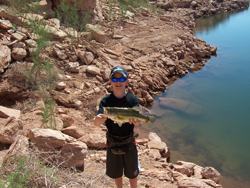|
Here Comes Spring (And The Spawn)
 By Wayne Gustaveson
By Wayne Gustaveson
Long-awaited spring warming is imminent. Bass have been poised all month on the edge of the flat waiting for warmth that will trigger the spawn.
Looks as if it will finally happen. There was some largemouth bass nest building and spawning in the northern lake early in the month, but the big smallmouth spawning event is still to come.
Sight-fishing for aggressive bass that have just spawned is exciting. Male bass that guard fresh eggs on the new nest will attack anything that comes close to “his nest.”
Aggression peaks for two days post-spawn and then tapers off each succeeding day after that. Timing the trip to coincide with actual spawning ensures a memorable trip.
That will happen this weekend and beyond.
Let The Guys Go
Catching bass is not all that technical in these conditions. Basically, anything that swims near the nest is fair game.
The lure choice is then determined by confidence of the angler. Past success with a certain lure, technique or presentation should determine how to fish during the next week. If it worked before, it should work even better now.
For beginners, perhaps the easiest and most effective bait is weightless plastic bait like the Zoom Fluke or Yamamoto Senko. Toss the bait beyond the nest, retrieve until it is over the nest, and then let it slowly descend right on the rocks.
The male bass will take it on the way down or pick it up and carry it off the rocks. Catch the male bass off the nest, but then release it to protect the eggs from predation.
If bass are to be kept for supper, keep the females or those fish not on nests. In the bass world, males determine the survival of the next generation, and females are excess fish to be harvested.
Crappie Also Spawning
Crappie will be spawning at the same time. Crappie will nest in thick cover and the male security guard will often be a very black color.
Release the black fish and those caught on nests to ensure the survival of the next generation. Use small plastic or hair jigs on very light jig heads (1/16th – 1/32nd ounce). Place them about 4 feet under a bobber to present the bait at a steady depth and a slow speed, which crappie prefer.
And Stripers Are Hot
Striper fishing is red hot in the channel near the dam. Use anchovy bait for a big catch of adult fish prowling the canyon walls.
Try the dam, Buoy 1, Antelope Canyon, Buoy 9, and Navajo Canyon for a big catch. Uplake start fishing at Moki Wall, Moki Canyon, and the wall upstream from the mouth of Moki. Lake Canyon and the mouth of Halls Creek are good as well.
Striper fishing is even better in the backs of canyons around brush piles that harbor small sunfish. Both adults and juveniles are hanging out in the backs of canyons.
Find them by fishing reaction baits like a lipless vibrator or jerk bait, on the shallow edge of the canyon near deep water. Cast to the shoreline much like fishing for bass.
Stripers, bass and walleye are sharing the same habitat. A hooked striper is usually accompanied by five others trying to grab the bait from its mouth. When one striper is being played, cast behind the hooked fish to catch the school mates.
Jerk baits like pointers, bevy shad, and Bomber long As work well, as do plastic grubs and tubes and spoons. Use your confidence lure. The fish will love it too.
At press time, lake elevation was 3,600, and water temperature was 57-66F.
|
|